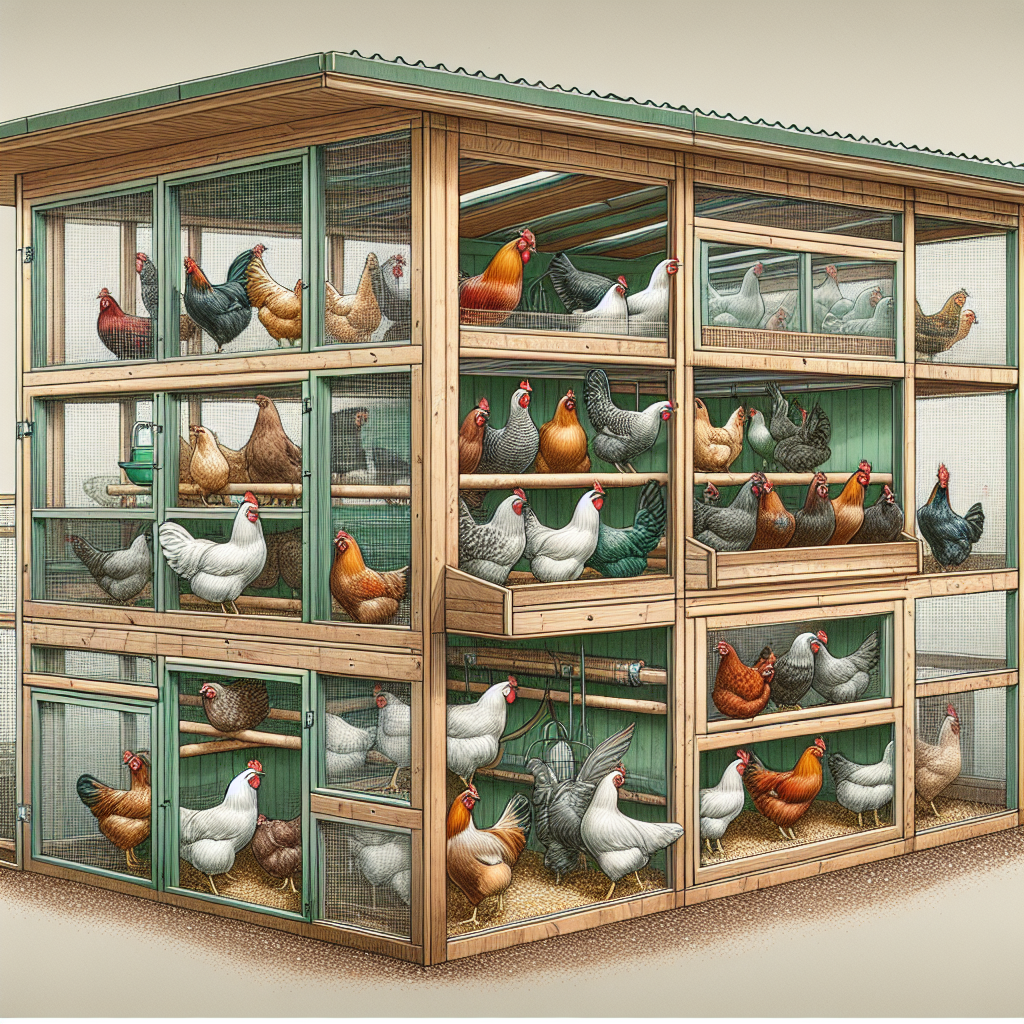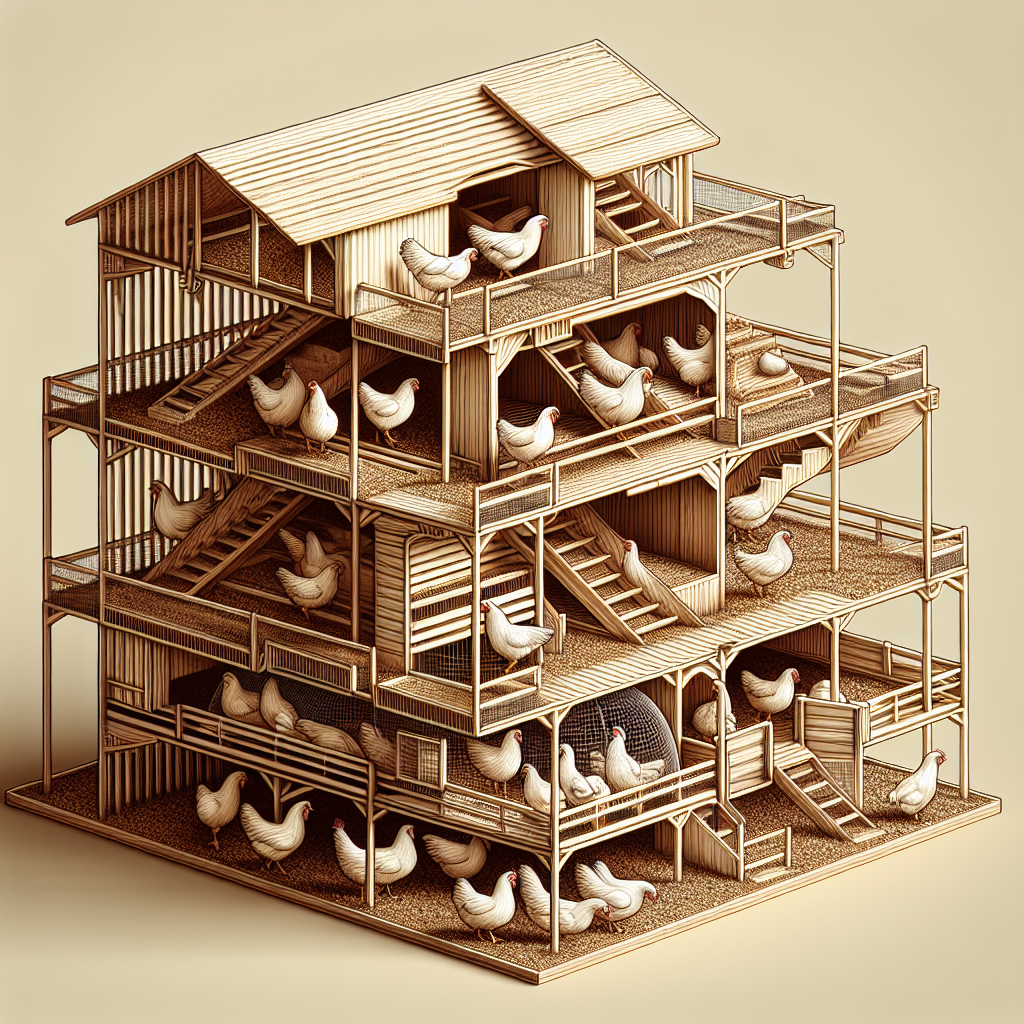Are you tired of spending hours scrubbing and maintaining your chicken coop? If so, you’re not alone. Every chicken owner knows how time-consuming and messy it can be to keep their coop clean. But here’s the good news: there are coop designs out there that are specifically optimized for easier cleaning and maintenance. In this article, we’ll explore some innovative coop designs that will not only make your life easier but also keep your chickens happy and healthy. Say goodbye to the days of scrubbing and hello to a more efficient and enjoyable chicken keeping experience. Absolutely! When designing a coop, there are several factors to consider in order to make cleaning and maintenance a breeze. By choosing easy-to-clean materials, creating a user-friendly layout, implementing efficient waste management systems, providing accessible cleaning areas, utilizing a modular design, incorporating automated cleaning systems, minimizing dust and odor, ensuring proper ventilation and natural light, and preventing pest infestation, you can create a coop that is not only functional but also easy to maintain.
Let’s delve into each factor in more detail to understand how it contributes to easier cleaning and maintenance.
Factors to Consider in Coop Design
Size and Layout
The size and layout of your coop are important considerations for easy cleaning and maintenance. A well-planned layout allows for efficient movement and accessibility to different areas of the coop. Ample space should be allocated for cleaning and maintenance activities, ensuring ease of maneuverability.
Material Selection
Choosing the right materials is crucial for easy cleaning. Smooth and non-absorbent surfaces, such as fiberglass or plastic, are preferable as they can be easily wiped clean and do not accumulate dirt or bacteria. Additionally, using durable and washable materials ensures longevity and ease of maintenance.
Ease of Access
Accessibility is key when it comes to cleaning and maintenance. Design your coop with wide doors and entryways to allow for easy entry and exit. Consider the height and placement of perches and roosts, making them easily reachable for cleaning and maintenance tasks.
Maintenance Requirements
Consider the maintenance requirements of different materials and design elements when planning your coop. Some materials may require more frequent cleaning or special maintenance, while others may be low-maintenance. Understanding and accounting for these requirements can save you time and effort in the long run.
Cleaning Time and Effort
Efficiency is paramount when it comes to cleaning and maintenance. By designing your coop with easy access to cleaning areas, minimizing hard-to-reach nooks and crevices, and using practical cleaning tools and equipment, you can significantly reduce the time and effort needed for regular cleaning tasks.
Easy-to-Clean Materials
Smooth and Non-absorbent Surfaces
Opt for materials that have smooth surfaces, as they are easier to clean and prevent dirt build-up. Non-absorbent materials, such as plastic or coated metals, are ideal as they do not retain moisture or odors, reducing the risk of bacterial growth.
Durable and Washable Materials
Choosing materials that are durable and washable is essential for maintaining a clean and hygienic coop. Consider materials like stainless steel, which can withstand frequent cleaning and disinfection without deteriorating or harboring bacteria.
Seamless Joints and Corners
Ensure that your coop has seamless joints and corners to minimize areas where dirt and bacteria can accumulate. Eliminating unnecessary gaps and crevices makes cleaning more efficient and prevents the buildup of debris.
Anti-microbial Coatings
Applying anti-microbial coatings to interior surfaces can help inhibit the growth of bacteria and pathogens, promoting a cleaner and healthier environment for your flock. These coatings can be applied to materials such as walls, floors, and nesting boxes.
Waterproof Flooring
Choosing waterproof flooring, such as epoxy-coated concrete or rubber mats, can prevent moisture absorption and facilitate easy cleaning. Waterproof flooring also minimizes the risk of bacterial growth and keeps the coop dry and hygienic.
User-Friendly Layout
Adequate Space for Cleaning and Maintenance
Design your coop with enough space for cleaning and maintenance activities. This includes allocating ample room for maneuverability, storage of cleaning supplies, and easy access to different areas of the coop.
Ergonomic Design for Easy Reaching
Consider the ergonomics of your coop design to ensure ease of reaching and cleaning various components. Design perches, roosts, and nesting boxes at appropriate heights, allowing for easy access without straining.
Clear Pathways and Accessibility
Create clear pathways within the coop to facilitate easy movement and cleaning. Avoid cluttering the space with unnecessary obstacles and ensure that essential areas, such as feeders, waterers, and nesting boxes, are easily accessible.
Well-Placed Feeders and Waterers
Strategic placement of feeders and waterers can simplify cleaning and prevent messes. Consider placing them in easily removable or accessible areas, making it convenient to clean and refill them without disturbing the flock.
Efficient Manure Collection System
Incorporate an efficient manure collection system into your coop design. This can include sloped floors with drains or removable trays that facilitate easy removal and disposal of manure, preventing the buildup of waste and odors.
Efficient Waste Management
Separate Waste Collection Area
Dedicate a designated area for waste collection to ensure easy removal and disposal. Separating waste from other areas of the coop helps maintain cleanliness, reduces odors, and prevents the spread of pathogens.
Use of Deep Litter Method
Implementing the deep litter method can simplify waste management. By regularly adding a layer of organic material, such as straw or wood shavings, to the coop floor, you create a composting system that breaks down waste and reduces odors over time.
Composting Systems
Consider incorporating a composting system into your coop design. Composting can effectively convert waste into nutrient-rich compost that can be used in your garden, reducing waste volume, and minimizing the need for frequent waste removal.
Easy Removal of Waste
Design your coop with features that allow for easy removal of waste. This can include removable trays or panels, sliding or retractable floors, or even integrating automatic manure removal systems that transport waste directly to designated areas.
Integration with Automatic Manure Removal
Automated systems for manure removal, such as conveyor belts or robotic devices, can greatly simplify waste management. These systems efficiently transport waste out of the coop, reducing the need for manual labor and streamlining the cleaning process.
Accessible Cleaning Areas
Easy-to-Reach Perches and Roosts
Ensure that perches and roosts are easily accessible for cleaning. Consider removable or collapsible designs that facilitate cleaning of these areas without disturbing or causing stress to the birds.
Removable Nesting Boxes
Design nesting boxes that can be easily removed for cleaning and maintenance. This allows for thorough cleaning and inspection, reducing the risk of contamination and offering a more comfortable and sanitary environment for your hens.
Sliding or Retractable Floor
A sliding or retractable floor can simplify cleaning by allowing easy access to the coop’s floor for thorough cleaning and waste removal. This design feature eliminates the need to reach tight corners or crawl into confined spaces.
Accessible Egg Collection Points
Make sure your coop design includes easily accessible egg collection points. Placing nesting boxes in accessible areas allows for convenient egg collection without disturbing the flock or causing unnecessary stress to the hens.
Convenient Door Placement
Strategically place doors to provide easy access to different areas of the coop. This facilitates hassle-free cleaning and maintenance, as well as ensures smooth entry of the birds during daily tasks.
Modular Design for Easy Access
Removable Panels and Walls
Incorporate removable panels and walls into your coop design. This allows for easy access to all areas of the coop, making it effortless to clean and maintain. Additionally, modular components facilitate repairs or modifications as needed.
Modular Nesting Boxes
Design nesting boxes that can be easily added, removed, or rearranged as required. This modular approach allows for flexibility in adapting your coop to suit different flock sizes and preferences.
Easy Disassembly for Deep Cleaning
Plan for easy disassembly of different coop components to facilitate deep cleaning. This includes features such as detachable flooring, removable walls, and disassemblable pen sections. Deep cleaning helps eliminate hidden dirt and potential sources of contamination.
Expandable Design for Future Expansion
Consider a coop design that can be easily expanded to accommodate a growing flock. An expandable design allows you to add or modify sections without compromising the structural integrity of the coop, providing flexibility for future needs.
Flexible Layout for Different Breeds
Design your coop layout to accommodate various breeds with different needs and sizes. This flexible approach ensures that each bird has adequate space and facilitates easier cleaning and maintenance by optimizing the utilization of the available space.
Automated Cleaning Systems
Automatic Watering and Feeding Devices
Automated systems for watering and feeding can significantly reduce cleaning and maintenance efforts. These systems provide the flock with a constant supply of fresh water and feed while minimizing spillage and waste, ensuring cleanliness throughout the coop.
Self-Cleaning Roosts
Incorporating self-cleaning roosts can greatly simplify the cleaning process. These innovative features automatically remove droppings from the roosting bars, reducing the time and effort required for regular cleaning and maintaining a hygienic environment.
Robotic Floor Cleaners
Robotic floor cleaners specifically designed for coop environments can automate the cleaning process. These devices are programmed to navigate the coop, collecting and removing waste, reducing the need for manual cleaning.
Automated Nest Cleaners
Automatic nest cleaners can streamline the cleaning of nesting boxes. These devices remove and collect dirty bedding material or debris, ensuring a clean and comfortable environment for your hens and simplifying your cleaning routine.
Waste Conveyors and Disposal Systems
Incorporating waste conveyors and disposal systems can efficiently remove waste from the coop. These systems transport waste from different areas directly to designated disposal points, eliminating the need for manual handling and reducing the risk of contamination.
Minimizing Dust and Odor
Well-Ventilated Coop
Proper ventilation is essential for minimizing dust and odor. Ensure your coop has adequate vents or windows to facilitate air circulation, reducing moisture, and preventing the buildup of bacteria and foul odors.
Effective Dust Control Measures
Implementing dust control measures can reduce airborne particles in the coop. This can include regular cleaning, using dust-reducing bedding materials, and incorporating air filters or purification systems to minimize the spread of dust.
Proper Bedding Materials
Choosing suitable bedding materials can help control dust and odor. Use absorbent materials like pine shavings or hemp bedding that effectively trap moisture and neutralize odors, contributing to a cleaner and more pleasant coop environment.
Regular Cleaning and Bedding Replacement
Maintaining a regular cleaning and bedding replacement schedule is crucial for minimizing dust and odor. By removing soiled bedding promptly and replacing it with fresh material, you can prevent the buildup of debris and keep the coop clean and fresh-smelling.
Air Filters and Purification Systems
Installing air filters or purification systems can effectively remove dust, allergens, and odors from the air within the coop. These systems help maintain better air quality, reducing health risks for both you and your flock.
Preventing Pest Infestation
Secure and Predator-Proof Design
Ensuring your coop is secure and predator-proof is essential to prevent pest infestation. This includes using strong and durable materials, reinforced doors and windows, and implementing effective security measures to keep unwanted visitors out.
Mesh Screen Protection
Covering vents, openings, and windows with mesh screens can prevent pests, such as flies and mosquitoes, from entering the coop. These screens allow for proper ventilation while keeping pests at bay.
Sealed Entry Points
Seal all potential entry points to prevent pests from gaining access to the coop. This includes gaps around doors, windows, and other openings where pests could squeeze through. Regularly inspect and seal any gaps or cracks to maintain a pest-free environment.
Pest-Repellent Coatings
Applying pest-repellent coatings to the exterior of your coop can act as a deterrent to potential infestations. These coatings are designed to repel pests, such as mites or lice, reducing the likelihood of infestations and minimizing the need for additional pest control measures.
Regular Pest Monitoring and Control
Implementing a regular pest monitoring and control routine is crucial for a clean and pest-free coop. Regularly inspect your coop for signs of pests, such as droppings or damage, and take appropriate measures to eliminate pests if necessary.
By considering these factors and incorporating them into your coop design, you can create a space that is not only comfortable and safe for your flock but also easy to maintain and clean. Remember, maintaining a clean and sanitary coop is essential for the health and well-being of your birds. Happy cleaning!




